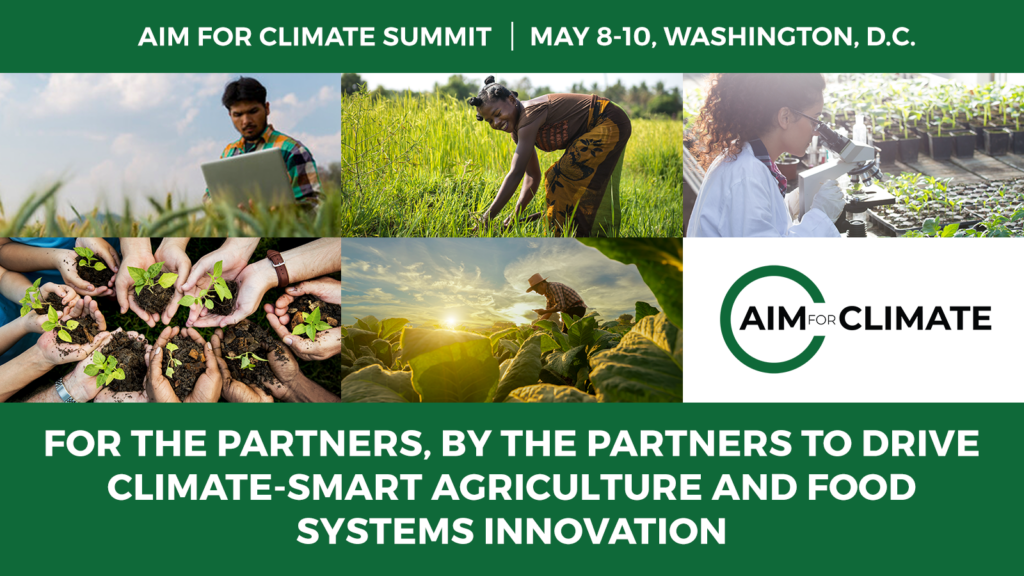U.S. Department of Agriculture (USDA) Secretary Tom Vilsack opened the Agriculture Innovation Mission (AIM) for Climate Summit 2023, where he announced AIM for Climate partners worldwide are ramping up investment in climate-smart agriculture and food systems.
The summit is taking place May 8-10, 2023, in Washington, D.C. The event serves to “raise ambition, build collaborations, and share knowledge on innovative solutions in the lead-up to COP28.”
Launched by the U.S. and the United Arab Emirates at COP26 in 2021, AIM for Climate puts agriculture at the center of climate action. The goal is to dramatically increase investment in and support for climate-smart agriculture and food systems innovation until 2025.
This year’s summit laid out the three key foundations of the partners’ plans:
- Increased investments. The increase of investments within the plan consists of over $13 billion, which exceeds the 2022 United Nations Climate Change Conference or Conference of the Parties’ (COP27) challenge of meeting $10 billion by the 2023 conference.
- Innovation sprints, or short periods of time dedicated to finding solutions. In this case, solutions to climate change are the goal. AIM for Climate enacted 21 new innovation sprints totaling a further $1.8 billion worth of investments. The sprints will be dedicated to “climate-smart agriculture and food systems innovation.”
- Partners. Lastly, the plan adds seven new partners. With their addition, partners total more than 500. The newest partners include Argentina, Fiji, Guatemala, India, Panama, Paraguay, and Sri Lanka.
USDA’s Science and Research Strategy
Secretary Vilsack also announced the release of the USDA Science and Research Strategy, 2023-2026: Cultivating Scientific Innovation.
The strategy outlines the organization’s scientific priorities for the next three years. The goal is to create a scientific foundation to revolutionize the U.S. food system and provide support for American farmers, ranchers, producers, and foresters.
Among other goals, the strategy highlights the role of the bioeconomy in reducing waste and emissions. The strategy calls for “science that supports sustainable markets for agriculture and forest bioproducts and clean energy.” Notably, the strategy calls for more support for “biotechnology and biomanufacturing capacity in food and agriculture to reach the bold societal goals for advancing the U.S. bioeconomy to support a sustainable circular economy,” noting programs like the Sustainable Aviation Fuel Grand Challenge and BioPreferred Program.
USDA’s International Climate Hub
Secretary Vilsack also announced the launch of USDA’s International Climate Hub. The hub “is a platform to share research, tools, collaborative efforts, and best practices on a global scale to improve the world’s ability to adapt to climate change and mitigate its impacts.”
Alongside the USDA’s International Climate Hub, the COMET-Planner Global Assessment tool will be used by global land managers to measure benefits of climate-smart conservation practices, leveraging USDA and Colorado State University’s experience.
BIO supports AIM for Climate

The Biotechnology Innovation Organization (BIO) joined AIM for Climate in 2021 as one of nearly 50 non-governmental Knowledge Partners.
“Climate change continues to impact longstanding agricultural practices in every country and a strong global commitment is necessary to face the challenges of climate change head-on and build more sustainable, equitable, and resilient food systems,” said Secretary Vilsack. “We need all of us working together to address the challenges of climate change and food security through innovative technology and approaches, and the AIM for Climate Summit gives me hope that we will rise to the occasion, as future generations depend on us to do.”




